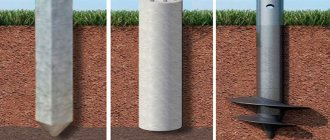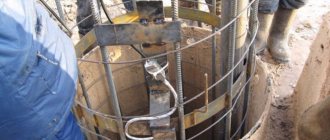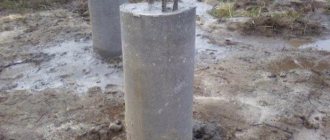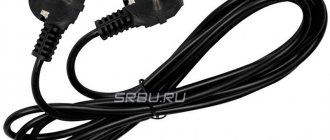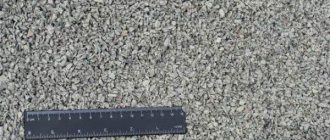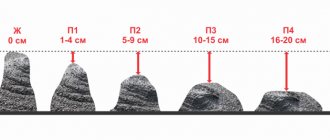Regulations for driving piles - regulatory documentation
Driving reinforced concrete piles - pile field
It should be understood that driving reinforced concrete piles is a labor-intensive process, requires the use of special equipment and is regulated by a number of regulatory documents (GOST, SNiP, TU, Standard Construction Series, instructions and orders). The list of basic standards allows you to understand how difficult this work is.
Detailed information can be gleaned from these documents, but to understand the process, we will provide brief information.
Pile driving scheme
The location of the pile is determined during the development of the project for the future structure. Moreover, each project is unique; its development is preceded by a study of the area (soil, temperature conditions, building density, the presence of underground communications, the possibility of access for equipment, etc.). Material prepared for the website www.moydomik.net
In private and industrial construction, the following pile installation schemes are used:
- pile bush (in private construction under columns, in corners, etc.);
- pile tape (in private construction and for linear structures);
- pile field (in private construction for very large and heavy houses, used mainly in industrial construction for multi-storey buildings).
According to SNiP, piles can be installed according to one of three schemes:
- typical diagram(s) of pile installation. Is the simplest. Suitable for use in sandy and gravelly soils. The use of this scheme involves installing piles in turn - from the first to the last.
Note. A prerequisite for using a row scheme is the presence of uncohesive soils. Otherwise, soil shrinkage may occur.
- sectional diagram of pile installation (b) . It is used when it is necessary to create a pile field when there is dense soil on the site. The specificity of using this scheme is that the piles of one section are driven first, then a row is passed, and the next section is formed. After all sections are arranged, the missing rows are filled in. The use of the scheme eliminates the risk of soil compaction.
- spiral (c) and (d) . Presented in two varieties. The first involves starting work from the middle of the pile bush, the second from its edges. The first method is recommended for working in dense soil, the second - in normal soil. The use of a spiral pattern ensures uniform redistribution of the load on the soil, which subsequently eliminates its movement.
The presence of a pile driving scheme (technological map) allows you to organize the work of equipment and the construction team, thereby minimizing time and money, and all operations are carried out quickly and accurately.
Pile driving scheme (technological map)
Bored pile driving method
Let’s make a reservation right away that the drilling method only indirectly relates to the methods of driving piles, because in this case the piles are created immediately on the site, but we will briefly describe it too. Piles are created by constructing a frame of reinforcement in a pre-prepared well, which is then filled with concrete. The well is created using a percussion or rotary drill.
Bored piles are created using one of the following methods:
- casing pipes. A pipe is installed in the well, which protects the walls from collapse. Then a reinforcement frame is created and the prepared concrete is poured. The pipe itself can remain in the well or be dismantled. Naturally, different pipes are needed in these two cases;
- without casing pipes. Concrete solution begins to flow into the well as it is drilled. It strengthens the walls and plays the role of a casing pipe. Next, a frame made of reinforcement is placed in the concrete. To distribute concrete more evenly, use a special pouring pipe with a vibrator at the end.
Finally, we note that the immersion scheme itself and the subsequent location of the piles is also of great importance:
- the row scheme assumes an evenly spaced arrangement of piles relative to each other. Suitable for sandy and gravel soils, not used on dense soils, easy to implement;
- the spiral scheme involves the arrangement of piles from the center of the foundation to its perimeter in a spiral. In this case, we can talk about the most even distribution of the load and reducing the likelihood of shrinkage;
- The sectional scheme involves installing two supports in one row, then skipping one row and installing two supports again. The entire pile field is traversed in this way, after which piles are installed in the missing rows. This option is suitable for areas with dense soil.
The construction of a foundation is a very responsible process that must be approached with an understanding of the soil characteristics, the specifics of the building being constructed and a number of calculations. The immersion method, together with other factors, affects the reliability of the foundation, so its choice must be taken seriously.
Source link
Piling technology
Driving reinforced concrete piles involves solving many issues, and choosing a scheme is only one of them. The second important choice is the decision about which technology for driving reinforced concrete piles will be used. Technology determines how piles are driven and what is used to drive piles under the foundation.
The choice of method is based on taking into account three factors:
- the soil . Each technology has its own characteristics, which are better revealed on a certain type of soil. In particular, we are talking about the speed of driving a pile;
- place . Some methods cannot be applied in urban areas, uneven terrain, the presence of underground utilities, etc.;
- pile _ Directly its length, cross-section, durability of the head.
Currently, pile driving technologies have gained recognition, which are listed in the table in descending order of popularity:
| № | Technology | Characteristic | Equipment |
| 1 | Percussion | Dynamic load | Hammer, pile driver |
| 2 | Pressing | Static load | Press |
| 3 | Vibration pressing | Dynamic and static load | Vibrator |
| 4 | Leader well | Dynamic or static load | Preliminary arrangement of the leader well, tools according to the selected technology |
| 5 | Softened soil | Dynamic and static load | Water supply, hydraulic hammer |
| 6 | Electroosmosis | Electricity | The pile acts as a cathode |
A brief overview of all the options shown in the table.
Impact pile driving technology
Considered the most productive. Allows you to drive up to 40 piles in one shift. The bottom line is that to drive the pile, the head is impacted using pile-driving installations (devices).
- hammer for driving piles. The hammer can be diesel, mechanical, steam-air, or hydraulic. Characteristics in the table:
Diesel hammers are considered the most popular. Characteristics in the table:
- pile driver. The driver's task is to correctly install the pile in the ground.
The productivity of the impact method is ensured by the action of two types of energy: impact (transmitted to the pile from the weight of the hammer) and explosive (due to the combustion of the fuel mixture).
The method has limitations due to the fact that the dynamic load applied to the pile head causes strong vibration. This makes it difficult to use the technology in densely populated areas or in dilapidated buildings of cultural or historical value.
How piles are driven using impact technology:
- complete driving of the pile. The impact power is 100% of the equipment power;
- installation of the pile and control of deviation from the vertical axis;
- the pile driver, using a winch, lifts the pile and delivers it to the pile driving installation;
- the pile is slinged and lifted;
- hammer work. The power of the first blows is 1/3 of the power of the equipment;
- failure or reaching the design depth.
Press-in piling technology
It belongs to the category of the most progressive, since the method is based on a static load. The pressing method can be used on any soil under building conditions of any density.
The essence of the technology is that the pile is constantly subject to a vertical load. The force of its impact increases until the design depth is reached or the soil fails.
Vibration-pressure technology for driving piles
A technology that combines the features of the previous two. In the case of its use, a vibratory driver acts on the pile head, which exerts a dynamic load of low amplitude. Thus, the pile vibrates slightly. Due to this, the density of the soil decreases, and the pile gradually sinks to a given depth from the static load. The method is justified for use in non-cohesive soil.
“Leader Well” pile driving technology
The leader drilling technology is an excellent alternative to the others, provided that the work is carried out in dense soil. The peculiarity of the method is to create a well with a diameter of 70% of the diameter of the pile trunk and a depth of 1 meter less than the length of the pile. Reinforced concrete piles will then be driven into the leader hole, which will push the already dense soil apart during the driving process. Due to this, the required strength of the pile installation will be achieved.
The technology is characterized by the absence of noise and vibration (when using a press) and high productivity (when using impact tools).
Pile driving technology “Softened soil”
The essence of the method is to change the characteristics of the soil. It has been noted that soil containing a significant amount of water has less resistance to loads.
Thus, the technology is based on the principle of water erosion (softening). To do this, a nozzle is placed on the heel of the pile, supplying water under pressure. The soil changes its structure and the pile goes in easily. At the same time, the last 1.5-2 meters of the distance the pile should be driven into the ground with a hammer.
Electroosmos pile driving technology
The technology is based on the use of electric current, which is supplied through the pile. The current softens clay soils, and the pile penetrates the soil more easily.
Methods
A feature of the pile driving technology is the need to pre-drill wells of the required depth. The next step is to organize the pile shaft. This stage can be carried out depending on the type of soil in one of three ways:
dry – produced without fixing the support walls;
In addition, the driving process itself can be done in different ways:
- by impact;
- vibration method;
- by pressing;
- screwing method;
- using leader wells for supports.
Sometimes several methods are used on the same foundation. Let's take a closer look at each of them.
Driving piles involves the use of a pile driver or other special equipment (for example, an excavator), on which a hydraulic hammer (or diesel or pneumatic hammer) is mounted for driving. A diesel hammer is a simple but effective hammer. It operates regardless of the availability of energy sources, has high performance and weather resistance.
The essence of the driving method is based on impact energy. With each blow to the tip, the element goes deeper into the ground until its tip rests on a solid base.
Vibration immersion involves reducing friction between the side surface of the supports and the walls of the well, so the method requires less stress. When vibrating, the displaced soil must be compacted around the pile, since this is directly related to the strength of the future foundation. It is carried out using loaders, hammers and special installations that provide vibration and deformation of the soil under the tips of the piles and in the area of their side walls.
The vibrating hammer in this technique is effective on moisture-saturated soils. For dry and dense soils, spring-type vibratory hammers are more suitable.
The indentation technology is one of the quietest. It is carried out due to a certain load on the piles, which is why they literally “fall” into the ground
The load comes from vibratory loaders and a hydraulic jack; it is important that the piles are pressed in under the influence of their own weight
The process involves several cycles of deepening and then removing the support until its tip stops and reaches the designed depth. Suitable for most types of soil, including those with deep dense layers. This method is not suitable for piles driven to a depth of more than 6 m. Due to the size of the equipment used, an area of at least 500 sq. m is required for its placement. In addition, this is a rather expensive way to organize a pile foundation.
Screwing technology involves the use of metal or reinforced concrete (RC) piles, which, in addition to the tip, have blades. The latter are necessary for immersion and screwing of supports into the ground. This method is used on flooded and fragile soils, and is widely used in urban construction, since it does not create noise and vibrations, and does not deform the soil layers of neighboring objects.
The method of immersing supports is considered the quietest and safest for the landscape. It is suitable for rocky soils, soils in the permafrost zone, soils with solid (up to 20%) inclusions.
The essence of the drilling method is that a hole (leader hole) is made in the ground, the diameter of which is less than the diameter of the pile. The height of the resulting well corresponds to the height of the pile without the tip. After this, a support is driven into the well.
A variation of the submersible method is drilling. In this case, the diameter of the well is slightly larger than the diameter of the piles, so after the piles are immersed, the free space between the walls of the hole and the walls of the support is filled with a cement-sand or soil mixture.
Well drilling is carried out using pile driver rigs equipped not with pile hammers, but with drilling rotators. The latter ensure a strictly vertical direction of drilling, which is a key indicator of drilling quality.
The process of driving reinforced concrete piles - stages
If we consider the complete process of driving piles, it can be described in several successive stages:
- delivery. Reinforced concrete piles are quite heavy products that need to be brought, unloaded and placed on the construction site in such a way as to minimize their movement during the driving process;
- development of a work plan. Taking into account the location of the pile and the work project, a route for the movement of the pile driver and hammer along the site is developed;
- site preparation. In particular: garbage removal, tree removal, leveling (if required), etc. In some cases, a pit is dug before installing the piles;
- marking the installation site of piles;
- marking the pile. The markings are applied with bright paint in increments of 1000 mm. The presence of marks allows you to control the degree and speed of penetration of the pile into the soil;
- equipment setup;
- driving piles using the selected technology.
Note. During the installation of each pile, the level of its deviation from the vertical axis is monitored. Permissible deviations are contained in the document (“Quality control of the construction of foundations from driven and bored piles”).
Various methods are used to drive piles
- impact method - driving piles with a hammer
- pressing method
- vibration method - driving piles using vibration
- drilling and installation of piles into a well (using leader drilling)
Impact method.
Driving is carried out with hammers of various types with a striking part weighing, usually 1.8 - 12 tons, mounted on heavy, usually tracked equipment (headframes, crawler cranes, cable and hydraulic excavators). Piles are driven into the ground by applying a vertical (sometimes inclined) load.
The base machine is used to hook the pile, lift it and drive it into the hammer head, which moves along the mast guide. Then the hammer drives the pile into the ground by releasing the impact part.
Driving the pile begins with several light blows, followed by increasing the force of the blows to maximum. If the position of the pile deviates from the vertical by more than 1%, the pile is corrected by supporting, tightening, etc. or pull it out and hammer it in again. Pile driving continues until the failure specified by the design is achieved - the amount of immersion of the pile from one hammer blow after the completion of driving. Driving piles when approaching the design value of immersion is carried out with “collaterals”, i.e. 10 hammer blows in a row. The immersion of the pile from one foundation is measured with an accuracy of 1 mm. Pile failure is determined as the quotient of the value of pile immersion from one foundation divided by the number of blows in the foundation.
Indentation method.
The pile driving method is used in the reconstruction of buildings that cannot be demolished because they are of historical value and are protected by law.
Pile failure during driving
The immersion depth of the pile is determined by the calculation method and is reflected in the project. However, in practice, the pile may not reach the calculated depth or may go below the specified level.
The case when a pile no longer sinks as a result of the force applied to it is called “soil failure” or “pile failure”.
The failure point can be calculated using the formula:
To make sure that the pile has definitely reached “failure”, a series of blows are performed (with impact technology) or the time during which force is applied to the pile head is increased (with pressing technology). These impacts, which do not lead to the advancement of the pile into the soil, are called “pledge”.
There is another term that describes the case when a pile does not sink due to overheating - “false failure”. In this case, work is suspended for a time sufficient to cool the tip of the pile located in the ground.
Note. If there is no failure to achieve the design depth, the piles are driven in after a four-day break. If failure is not achieved, you should look for the reasons and change the driving procedure in order to prevent a decrease in the design bearing capacity of a particular pile.
Impact methods for driving prefabricated piles
Prefabricated reinforced concrete piles
The driving of piles is carried out using special self-propelled impact or rail installations, so before carrying out the work it is necessary to level the construction site. The pile is secured in a vertical position using pile drivers. Externally, they look like arrows that allow you to lift and secure pile supports.
The driving process at the initial stages is slow, since it is necessary to set the direction of movement of the pile without making even minimal errors. When it sinks into the ground to a sufficient depth, the installation begins to work with a gradual increase in the driving speed to the maximum possible. The driving process is considered complete when the support is immersed to the designed depth or if no changes in its position are observed during operation of the hammer for some time.
Do-it-yourself pile driving
Despite the fact that driving reinforced concrete piles generally requires the use of specialized equipment, it is quite possible to implement it yourself. Let's look at how to drive piles manually, with the caveat that the pile has dimensions acceptable for work.
Do-it-yourself installation of piles is carried out using impact technology. To organize a dynamic load, you need to assemble a tripod, hang several concrete blocks on it (serve as a counterweight) and a hammer. The hammer is raised by cables to the maximum height and fixed. Once the pile is installed, the hammer is released and the pile is driven into the soil. The procedure will be repeated until the required depth is achieved.
Machines and equipment for driving piles
Diesel hammers based on full-rotary excavators of the EO series are used. Excavators are crawler-mounted and serve, by and large, to move piling equipment. The piling equipment is the mast and the hammer itself. The hammer moves along guides on the mast.
But the most effective pile drivers with a hydraulic hammer are: Junttan PM20, Junttan PM22, Junttan PM25, Hitachi KH-150-3. Hitachi KH-180-2, Nippon-Sharyo DH, Banut, PVE, Liebherr.
If necessary, the hammer can be replaced with drilling equipment for leader drilling. When relocating from object to object, the hammer and mast (consisting of 2-3 parts) are removed from the base machine. Considering the oversized dimensions and weight of the pile driver, its relocation is carried out with a special permit from the traffic police with escort.
